Instructions for self-repairing motorcycles Kawasaki ZX-6R (Ninja)
See this section in russian language
This manual is intended to assist in the repair and maintenance of Japanese motorcycles "Kawasaki ZX-6R Ninja" third generation with codes ZX600-J1 or ZX600-J2, which were produced from 2000 to 2002.
Description and history of Japanese motorcycles Kawasaki ZX-6R (Ninja)
| Content: | ZX600F ZX600G ZX600J ZX636A ZX636B ZX636C ZX600P ZX600R ZX636E ZX636G ZX636J Tech data |
The Kawasaki Ninja ZX-6R, often simply referred to as "Ninja", is a motorcycle in the supersport category from the Japanese manufacturer Kawasaki, initially with a displacement of 599cc and later also 636cc.
The ZX-6R has been in production since 1995 and has been continuously developed since then. In some countries in Europe, Asia, and Australia, the version developed in 2002 is referred to as "636cc"; the international uniform internal designation is ZX6xxX.
Common features of all models include:
- Four-cylinder inline engine with 2 overhead camshafts (DOHC) and 4 valves per cylinder, mounted transversely.
- Telescopic fork or upside-down fork at the front, dual-arm swingarm with a central shock absorber at the rear.
- Frame made of welded aluminum profiles, six-speed transmission, electronic ignition.
- Ram-Air intake that allows for increased performance at high speeds.
- Wet sump pressure circulation lubrication.
- Multi-disc clutch in an oil bath, mechanically operated.
ZX600F (1995-1997)
After Kawasaki successfully positioned the Ram-Air system and an aluminum perimeter frame in the market with the ZZR 600, which was criticized for its high weight, the introduction of the Ninja ZX-6R triggered a manufacturer-wide arms race in this class. The ZX600-F, as it is internally designated, completes the sprint from 0 to 100 km/h in 3.6 seconds, weighs a remarkable 206 kg when fully fueled (182 kg dry), has an engine output of 74 kW/100 hp (version for the German market), and was produced until 1997. For the global market, the ZX600-F had an output of 77 kW/105 hp; in the German market, the restricted version with 72 kW/98 hp is often found for insurance reasons.
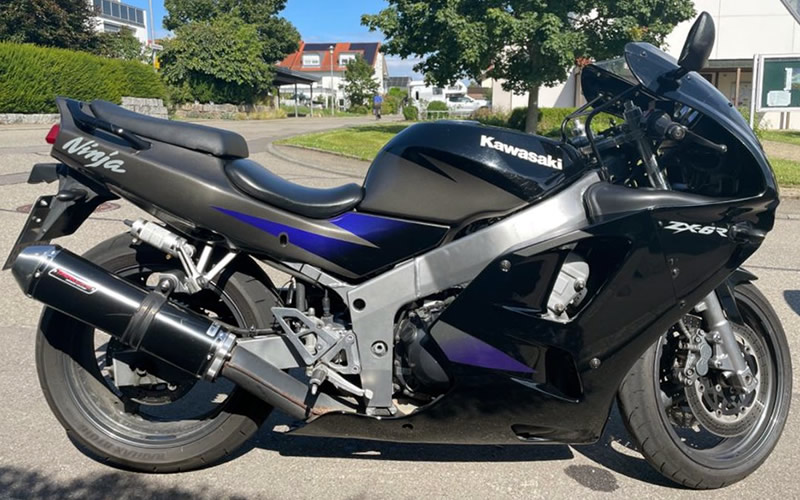
ZX600-F, 1996 year, right view
In this generation, the Ninja was still equipped with four carburetors, a fuel tap, and a choke lever. In 1995, the ZX-6R had a price of 16160 DM in Germany, including delivery costs.
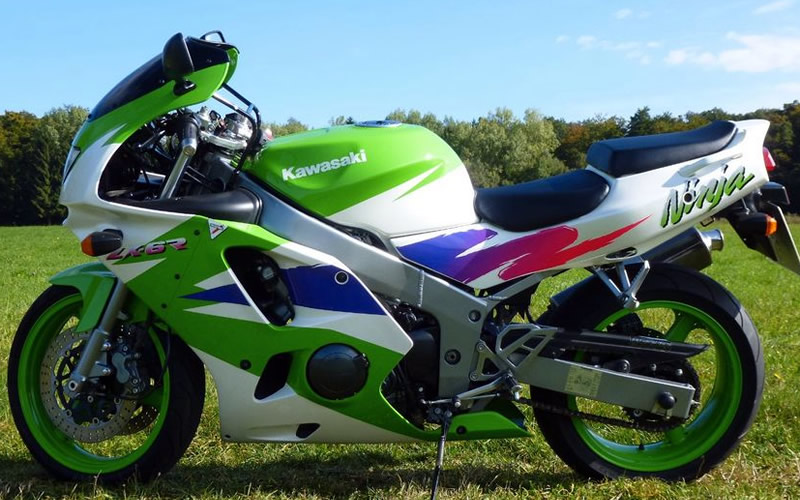
ZX600-F, 1995 year, left view
Somewhat unusually, the design of the parking light in the first generation was integrated as an additional lamp unit above the main headlight in the front fairing. The ZX-6R was nearly identical to the more powerful ZX-9R (1994–1997) apart from the engine, differing mainly in a slightly different design pattern, a headlight with a lens insert (which also fits the ZX600F), and an instrument cluster with a fuel gauge. Various test reports confirmed that the motorcycle offered a package of chassis and engine performance previously unseen in mass production, suitable for both street and track. As is common with many Kawasaki models, this vehicle was available in different color variants and concepts (e.g., red with white "Ninja" lettering, silver with black-red "Ninja" lettering) depending on the model year.
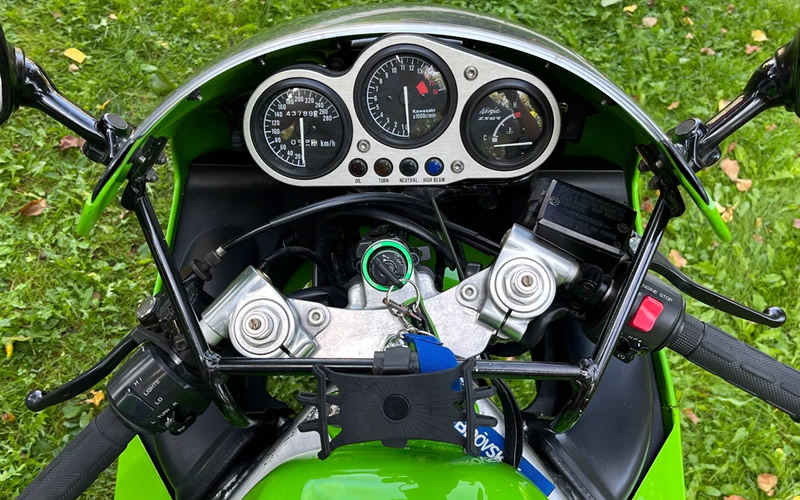
ZX600-F, 1997 year, dashboard
The Ninja series is particularly known for the typical, intense "Lime Green", which Kawasaki introduced with these models (starting with the ZX-9R in 1994) and has remained characteristic of the entire product range to this day. A plastic cover was available as an accessory for this model to replace the passenger seat. Under the passenger seat, there is a small compartment equipped with tools. Through this compartment, the rider's seat can be removed to access the battery.
ZX600G (1998-1999)
After the Japanese competition had caught up with similarly powerful models, a new model with a completely new frame and a stiffer 46 mm fork was introduced in 1998, which was lighter at 176 kg dry weight and also slightly more powerful with Mikuni instead of Keihin carburetors, producing 79 kW. The design was slightly modified, and a 6-piston brake was used at the front instead of the previous 4-piston version. With the Kawasaki Low Exhaust Emission Catalytic Converter System (KLEEN), the ZX-6R was available for the first time with an (ungoverned) catalytic converter for an additional 300 DM.
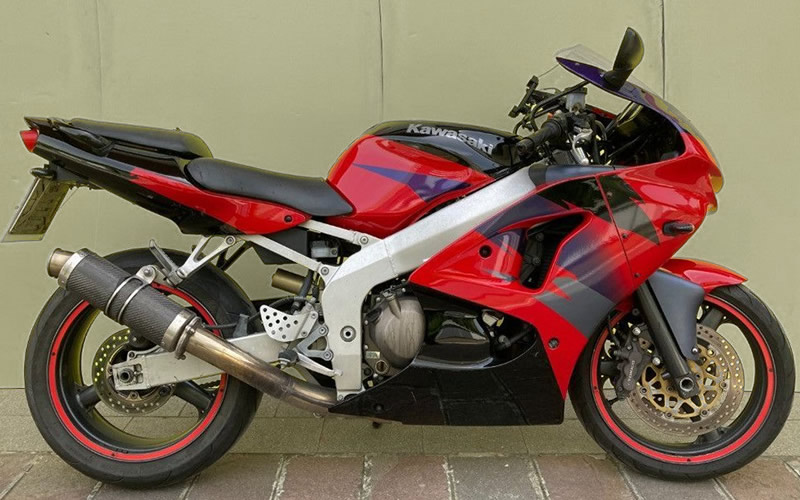
ZX600-G, 1998 year, right view
ZX600J (2000-2002)
The 2000 model ZX600J features shorter intake channels, higher compression (requiring super fuel from this model generation), lighter aluminum cylinders instead of cast iron, and less rotating mass, resulting in a slightly higher output. Another 4 kg was saved in weight. The press noted improved acceleration despite a less full torque curve. The handlebar halves are now mounted under the fork bridge, resulting in a sportier riding position. Additionally, the extended trail and slightly stiffer chassis tuning with increased damping and spring rates, as well as the provision for mounting a steering damper, were aimed even more at track use.
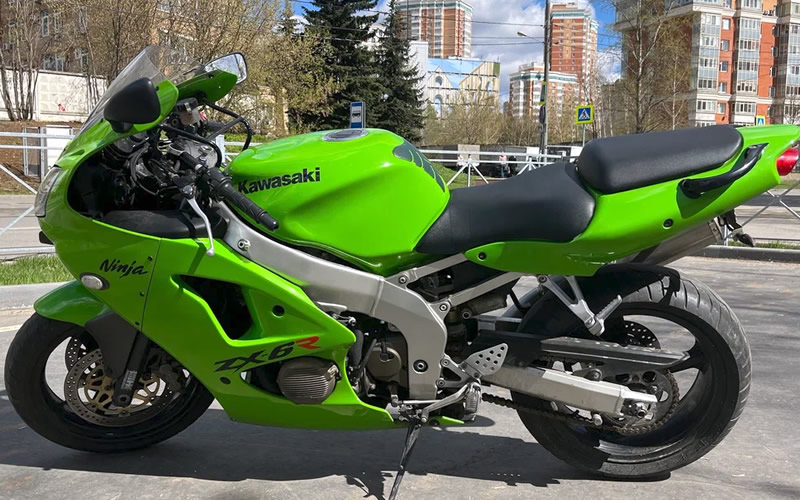
ZX600-J, 2001 year, left view
The fairing received a new color scheme, and the shape of the nose was changed: the headlight was designed as a dual headlight, and a protruding lower lip was intended to supply more air to the Ram-Air system.
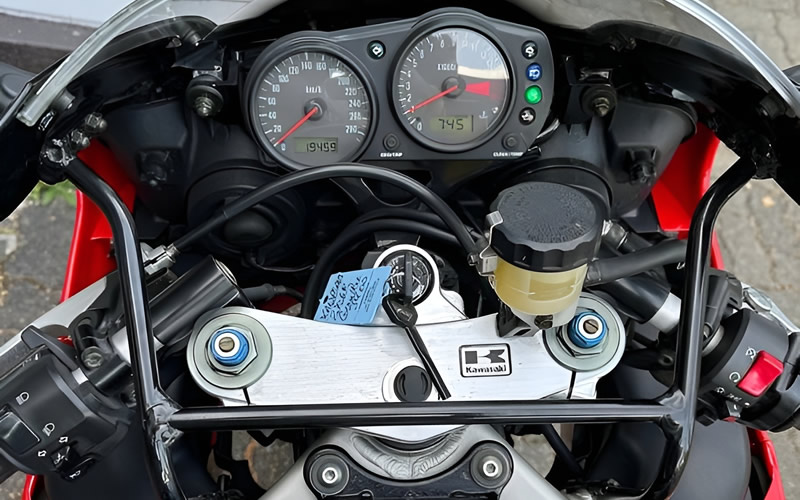
ZX600-J, 2000 year, dashboard
ZX636A (2002-2003)
After the competition with the Yamaha YZF-R6, Honda CBR600, and Suzuki GSX-R 600 successfully catered to the 600cc class, Kawasaki made an unusual move in 2002: the engine displacement was increased by 6 percent to 636 cm³ through a 2 mm larger bore (68 mm). Tests confirmed that the new engine delivered noticeably better torque and power delivery. The magazine MOTORRAD stated in issue 6/2002: "It delivers […] acceleration values that make the entire 600cc competitors look outdated".
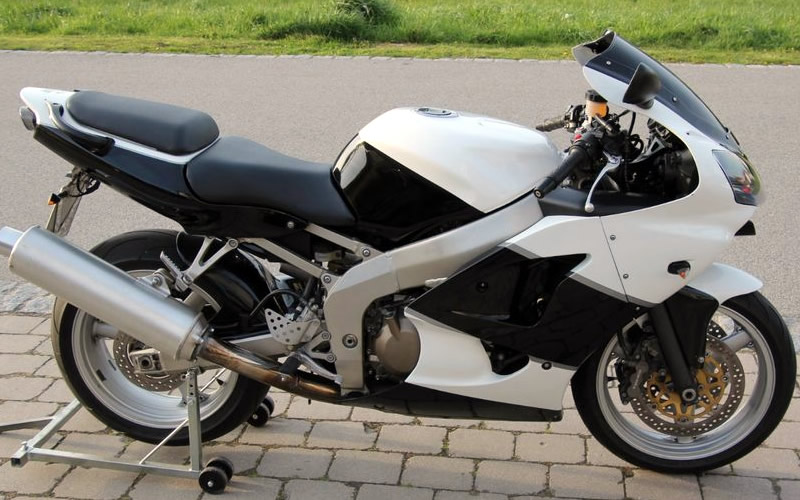
ZX636-A, 2002 year, right view
Compared to the predecessor generation, Kawasaki changed relatively little in terms of technology aside from the engine. The front suspension was upgraded with a new design of the fork seals, improved internals, and revised damping rates.
ZX636B (2003-2004)
Just a year later, many elements were redesigned: the engine now featured fuel injection instead of carburetors, which was noted in tests for its good responsiveness, unlike some other engines with similar fuel injection systems. Two throttle valves were used, with the lower one controlled by the throttle cable and the upper one regulated by electronics.
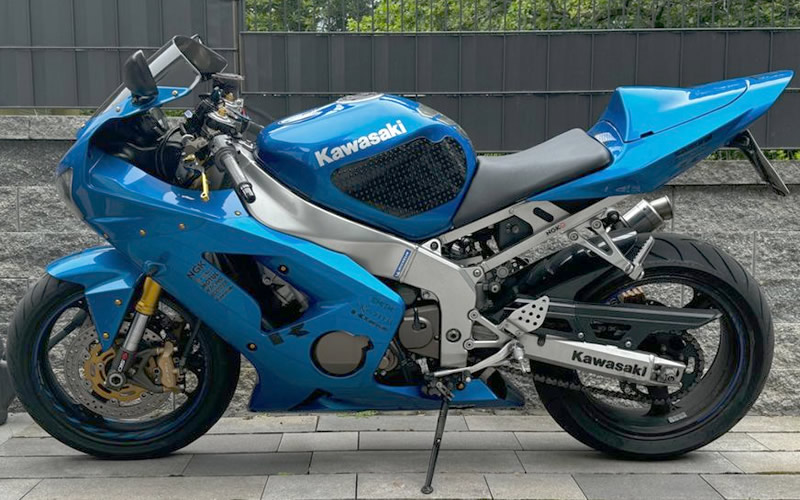
ZX636-B, 2003 year, left view
Additionally, the nominal engine speed was increased by 500 rpm, resulting in an additional 6 horsepower and a closer gear ratio. An anti-hopping clutch was introduced for the first time in this model series. Radially mounted 4-piston brakes with four individual pads replaced the previous 6-piston system, improving responsiveness and controllability. A new upside-down fork was introduced at the front, and the suspension was adjustable within wider limits, making the motorcycle overall 9 kg lighter. The compact instrument package included an LCD perimeter tachometer that was difficult to read in sunlight, a digital speedometer with large digits, an adjustable shift light, and a lap timer. Additionally, the Ram-Air intake was relocated to the center above the headlights. For sport riders wanting to compete in the 600cc racing classes, a ZX-6RR (ZX600K/M) with 600 cm³, a slightly different chassis, and a higher price was offered in parallel.
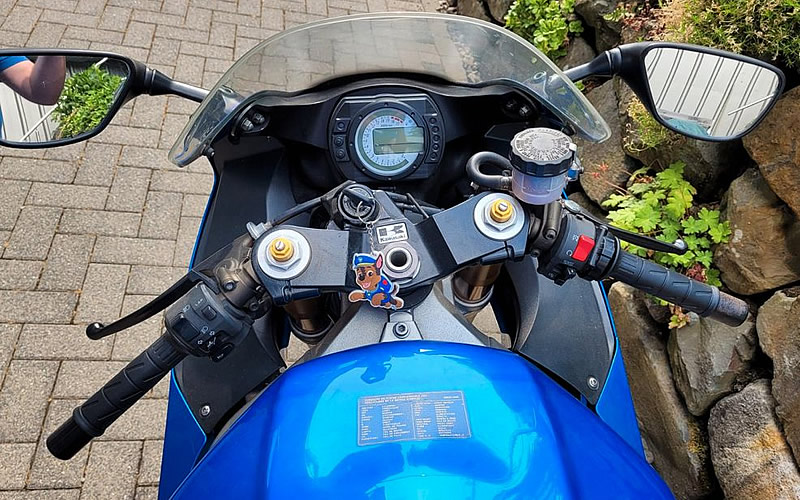
ZX636-B, 2004 year, dashboard
In the 2004 model, only the rear shock was renewed, which is better adjustable for lighter riders, and the color silver was also available.
ZX636C (2005-2006)
To compete with the performance of rivals, the 2005 model saw the nominal engine speed increased by another 1000 rpm, resulting in 130 horsepower at 14000 rpm and 136 horsepower with the RAM-Air system; the frame and swingarm were modified. Following current trends, the aluminum frame was painted matte black, and the fairing featured more curves and integrated turn signals.
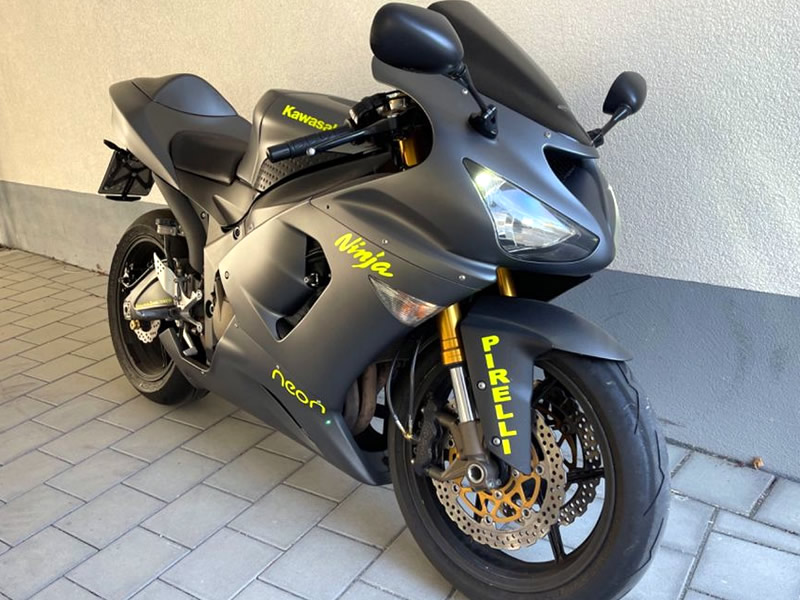
ZX636-C, 2005 year, front view
The exhaust was now routed centrally under the seat, and so-called wave brake discs were used. An anti-hopping clutch was also installed to reduce the braking moment that occurs during downshifting, which can lead to rear wheel hopping at high RPM.
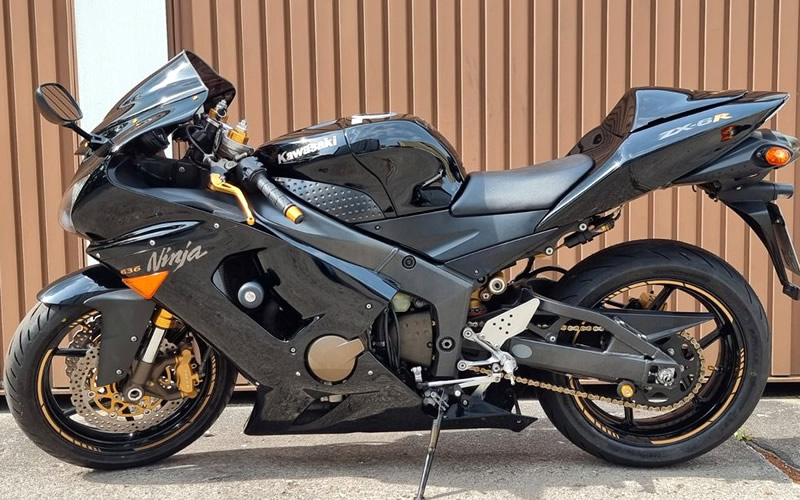
ZX636-C, 2006 year, left view
Another significant change from the predecessor model ZX636B involved the fuel injection system. The ZX636C features dual fuel injection. In addition to the channel nozzles, the ZX636C has a so-called shower nozzle bank installed over the intake funnels. These are designed as 3-hole nozzles and are activated at higher engine speeds to improve cylinder filling. Conversely, at lower RPMs, the fuel dosing can be improved using only the channel nozzles. Furthermore, the intake funnels are oval-shaped, allowing for a larger intake cross-section while maintaining the same width of the intake housing.
With the ZX600N, a ZX-6RR with 600 cm³ is again offered for the 600cc racing class.
ZX600P (2007-2008)
For 2007, a new development was realized, which, according to the manufacturer, was "consistently developed for track suitability". The division into two displacement variants was eliminated; the engine has 599 cm³ and achieves 125 horsepower at 14000 rpm. Additionally, it was completely newly designed to achieve a particularly "broad power band"; the compression ratio reaches an unprecedented value of 13.9:1 for production engines. The Euro3 emission standard is also met. The frame and fork are new, and the rear shock is now mounted on a uniball joint.
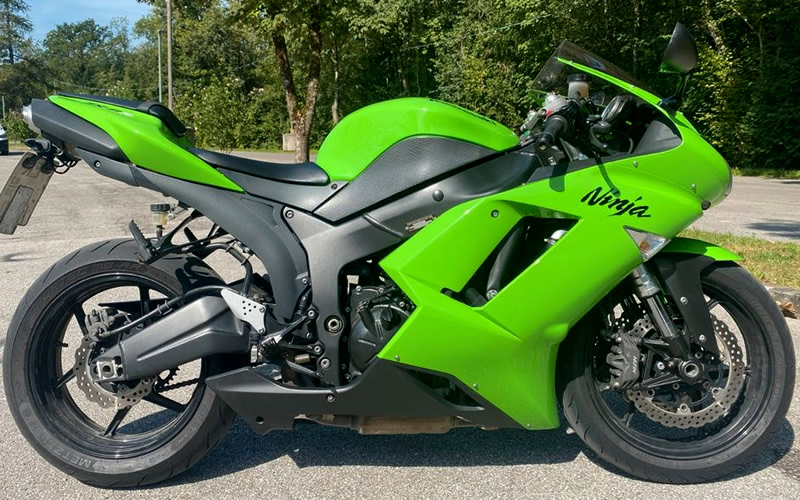
ZX600-P, 2007 year, right view
Also new is the transmission, which is now designed as a cassette gearbox, an unusual feature for a mass-produced motorcycle, allowing for the change of gear ratios to adapt to a racetrack. The design of the fairing and front has been aligned with the larger sibling, the Ninja ZX-10R, and the exhaust exits in a dual-ended pipe under the tail, with the swingarm and tail being constructed in a slightly more delicate manner.
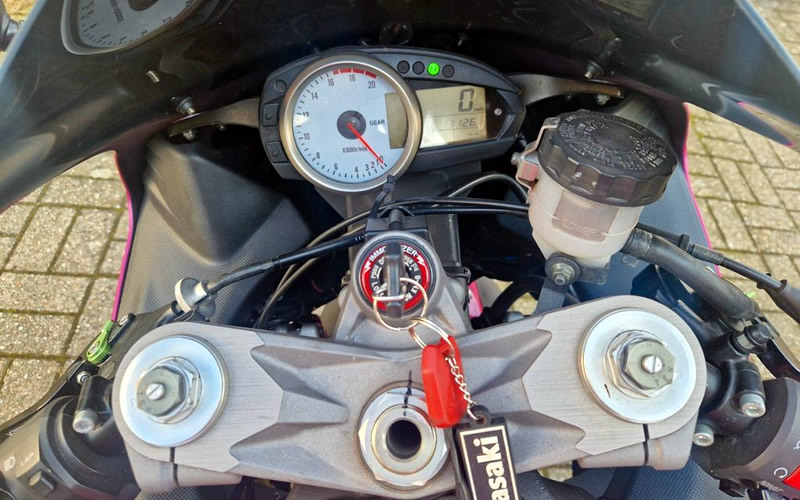
ZX600-P, 2008 year, dashboard
ZX600R (2009-2012)
After the previous generation's compliance with Euro 3 emissions standards came at the cost of slightly reduced performance, the engine power was increased again to 128 hp (134 hp with RAM-Air effect). The weight also returned to the level of two generations prior. Mass centralization was further advanced through a new exhaust (which is routed from its position under the passenger seat back out to the right side) and a more upright position of the cylinder bank in the frame, allowing the radiator to be positioned closer to the center of mass. This also made it possible to steepen the steering head angle to further improve agility and handling.
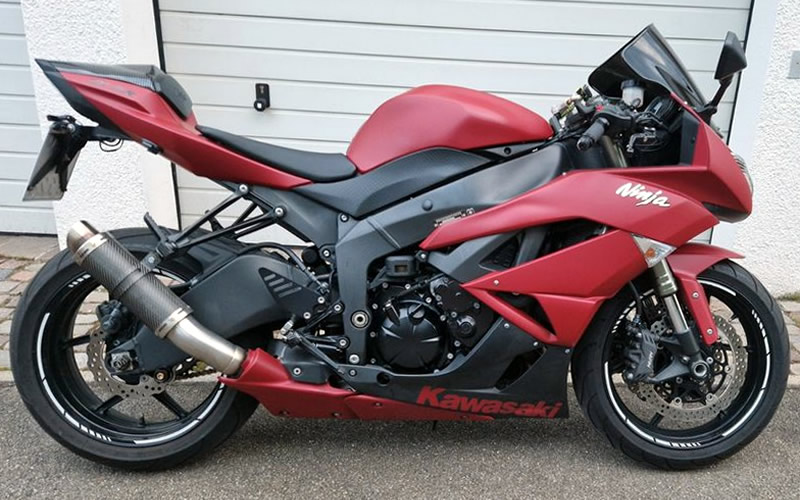
ZX600-R, 2010 year, right view
A completely new feature is the "Big Piston Fork" (BPF) from Showa, which was developed together with the ZX600R and was used for the first time in mass production. Unlike a conventional cartridge fork, where damping occurs inside the cartridge component, the pistons in the BPF run directly along the inner walls of the fork tubes. This means the fork consists of fewer parts and offers another significant advantage: the piston is larger, providing a correspondingly larger surface area. As a result, the pressure in the oil could be reduced while maintaining the same damping force, making the fork more sensitive and precise. Additionally, several hundred grams of damping oil are saved.
ZX636E (2013-2018)
In terms of safety and assistance systems, Kawasaki opened a new chapter in 2013: for the first time, a supersport motorcycle in the 600cc class from the company was equipped with ABS and traction control. The three-stage adjustable and optionally deactivatable KTRC (Kawasaki Traction Control) offers Mode 1 for low traction control with significant slip, Mode 2 with stronger traction control for sporty riding with limited slip, and Mode 3, which eliminates any slip risk (the regulation activates at the slightest deviation between front and rear wheel speeds to prevent skidding). This is particularly advantageous on poor roads or wet surfaces.
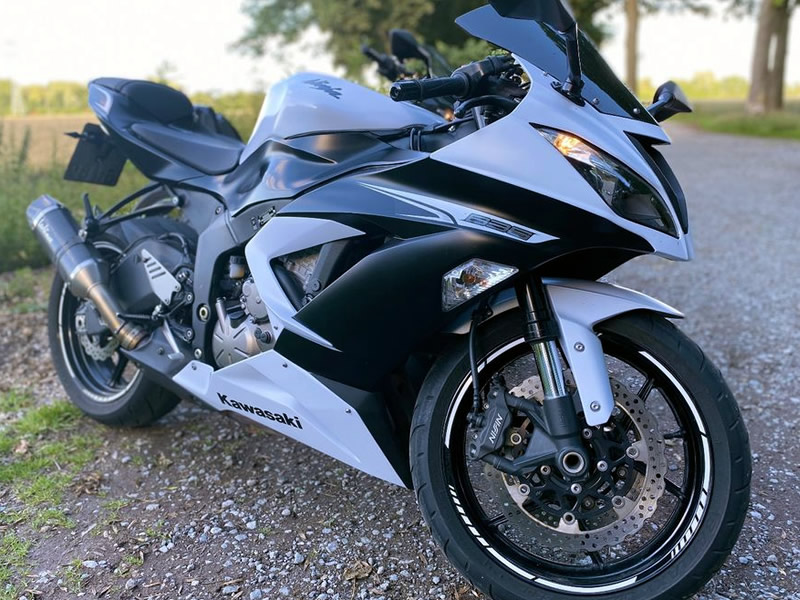
ZX636-E, 2014 year, front view
Independent of the traction control, there is also a power regulation available in two settings: "Full" and "Low". In "Full", 100% of the engine power is transmitted to the rear wheel, while "Low" limits the power to 80%.
To achieve more torque in the mid-range, Kawasaki opted for increased displacement again, this time through a longer stroke while maintaining the same bore. Consequently, the airbox grew by over half a liter, the camshafts were adjusted, the mixture flows through longer intake funnels, and the intake valves open longer and wider. On the exhaust side, everything up to the silencer was optimized for more torque. In the last gear, the ZX636E not only outpaces its Japanese class competitors in all disciplines by often more than a second but sometimes even surpasses the 1000cc machines.
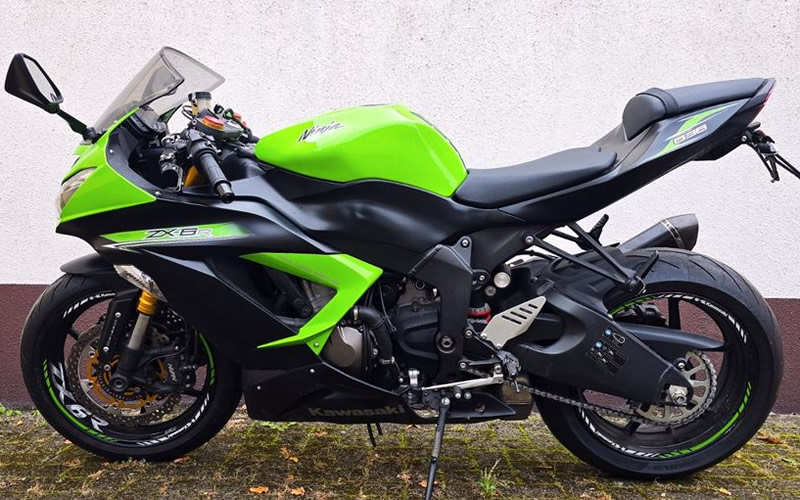
ZX636-E, 2015 year, left view
In 2017, this generation was phased out in Europe as it did not meet the Euro 4 emissions standard and initially found no successor in 2018. Kawasaki deemed the development or adaptation to the new emissions standard too costly. In the 2016 model year, the ZX-6R 636 — this time the exact sales name — was already priced at €13195, increasingly approaching the price range of 1000cc machines.
In parallel to the 636cc version, a race-compliant variant with 600cc was offered (sales name ZX 600 R). This model had slightly less power and torque due to a shorter stroke (42.5 mm) (94.1 kW at 14000 rpm; 66.7 Nm at 11800 rpm) but utilized a higher compression ratio of 13.3:1. The "Performance" edition offered for both variants differed only by a tank pad, tinted bubble windshield, passenger seat cover, colored wheel rings, and an Akrapovic end silencer from the regular version. The power remained unchanged.
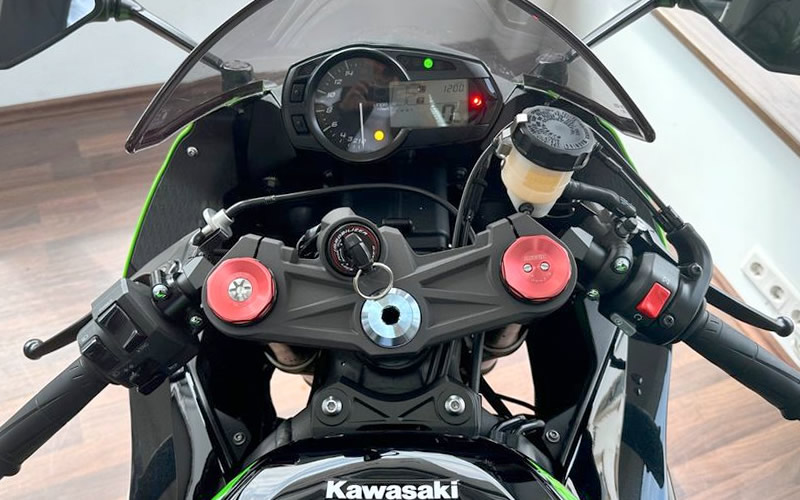
ZX636-E, 2016 year, dashboard
To celebrate the 30th anniversary of the Ninja ZX-6R model series, a special anniversary model called "30th Anniversary Ninja ZX-6R 636" was released in 2015, featuring a three-color special paint scheme in Lime Green/Pearl Stardust White/Flat Ebony and the Ninja Anniversary logo on the tank.
ZX636G (2019-2023)
With the 2019 model year, the ZX-6R — once again with a displacement of 636 cm³ — makes its return to Europe. The diameter of the intake valves was increased from 38 mm to 47 mm. The multi-point fuel injection system is equipped with two injectors per cylinder. At the same engine speed (13500 rpm), the 2019 Kawasaki ZX-6R now produces 130 hp, while the maximum torque remains almost unchanged but is now available at 11000 rpm.

ZX636-G, 2020 year, left view
As the 600cc class became increasingly expensive due to technical upgrades such as ABS, traction control, and increasingly complex exhaust after-treatment, there was a significant decrease in price for the first time, while a model generation also remained on the market longer. The 2019 Kawasaki ZX-6R was available starting at €11695. Nevertheless, there was a new abundance of standard features: quickshifter, fully adjustable Showa BFF fork, high-performance brakes, three-stage adjustable traction control, LED headlights, and a multifunction display in the cockpit. The latter integrates an analog speedometer, while gear, consumption, and range are displayed on an LC display.
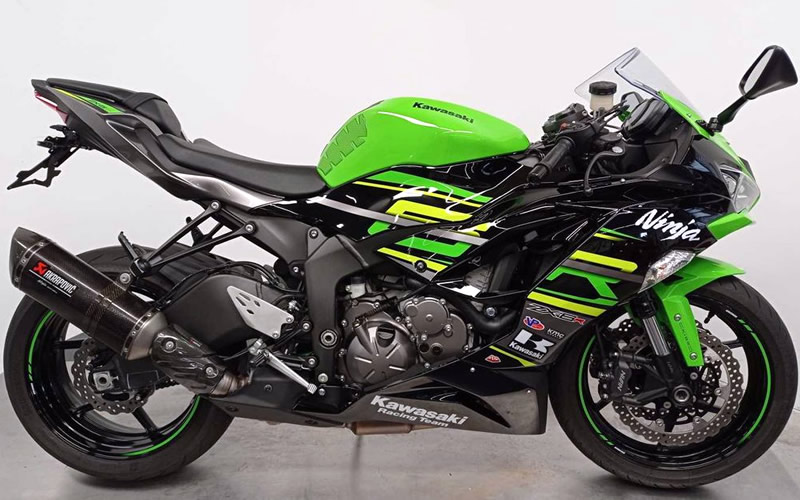
ZX636-G, 2021 year, right view
The "Performance" edition differed this time, in addition to the tank and knee pad, passenger seat cover in vehicle color, and an Akrapovic end silencer, with a slightly increased power output of 96.4 kW at 13500 rpm and a minimally increased torque of 71 Nm at 11500 rpm. The KRT edition, on the other hand, is technically identical to the standard version and differs only in its visual design inspired by the Kawasaki racing team.
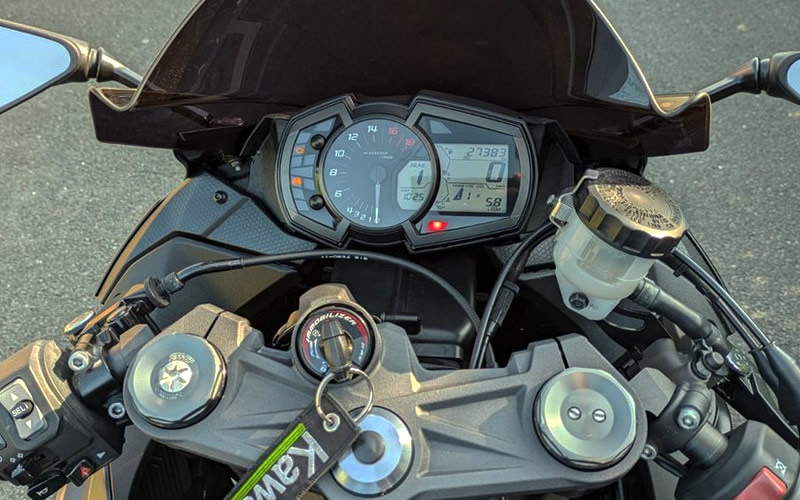
ZX636-G, 2019 year, dashboard
Two years later, in 2021, Kawasaki once again bid farewell to the European market with the ZX-6R, after the EU extended the originally 2020 deadline for selling already produced Euro 4 motorcycles until the end of 2021. Outside of Europe, the ZX-6R never disappeared; it continued to be sold in both America and Asia based on the model introduced in 2019.
ZX636J (2023-current)
While the global market for supersport motorcycles in the 600cc class has shrunk to a fraction of its peak in the 1990s, Kawasaki introduces an update for its Ninja ZX-6R that aims to surpass the aging Japanese competition in terms of technology. The existing electronics, such as ABS, wheelie control, launch control, traction control (KTRC), quickshifter, and selectable power modes, are complemented by a full-color TFT instrumentation with a range of new features, including smartphone connectivity and integrated riding modes.
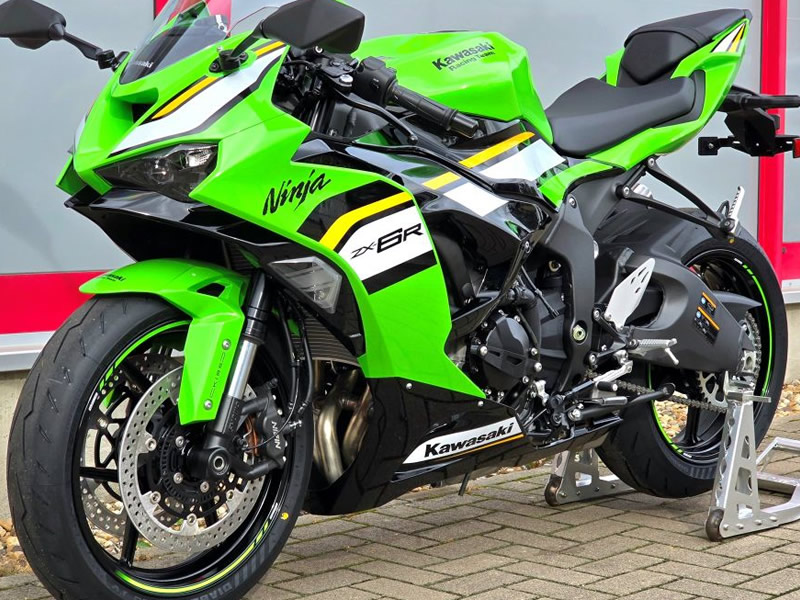
ZX636-J, 2023 year, front view
The updated model, internally designated "ZX636J" and "ZX636K", appeared in the EPA list for street-legal motorcycles in spring 2023, and Kawasaki officially unveiled the machine on June 6, 2023. The EPA document indicated in advance that the motorcycle is less powerful than the previous version. As was the case with the introduction of the ZX600P meeting Euro 3 emissions standards, compliance with international emissions limits is particularly challenging for high-revving, high-performance motorcycles. The EPA document specifies a maximum engine speed of 13000 rpm, suggesting that Kawasaki has limited the overall engine speed to meet emissions standards. Since US emissions regulations have not changed, the adjustments are due to the need to comply with the latest Euro 5 standards, which had previously led to the ZX-6R being removed from the European market.
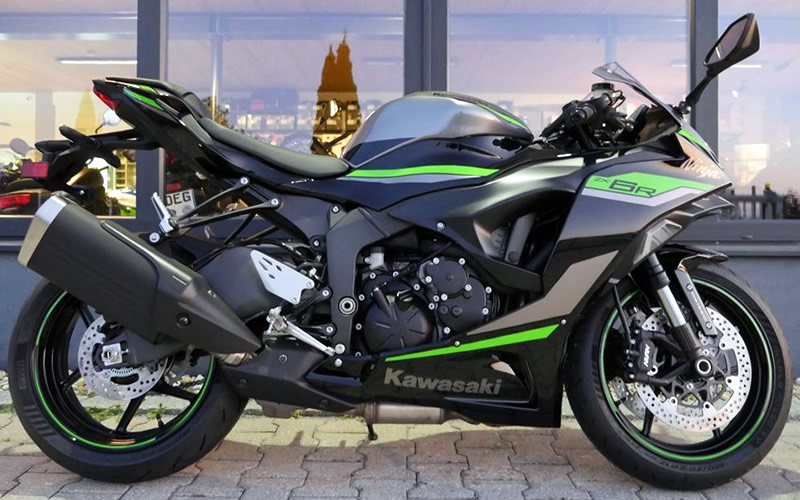
ZX636-J, 2024 year, right view
The emissions specified in the EPA document for the new model largely resemble those of the old model but show a slight increase in NOx and CO emissions compared to the predecessor model. However, according to Euro 5 regulations, there is also a specific limit for "non-methane hydrocarbons", which is particularly difficult to achieve for high-revving motorcycles. Essentially, the large valve overlap (the period during which the intake valve opens before the exhaust valve closes), which is necessary to efficiently fill the cylinder with charge at high RPMs, results in too much unburned fuel escaping into the exhaust at lower RPMs. This could be compensated for by retuning the engine, revising the profiles of the camshaft, intake funnels, and exhaust system, as well as reducing peak power and RPM. Another change involved the axle gearing, which was given a longer overall ratio to accommodate the lower RPM engine.
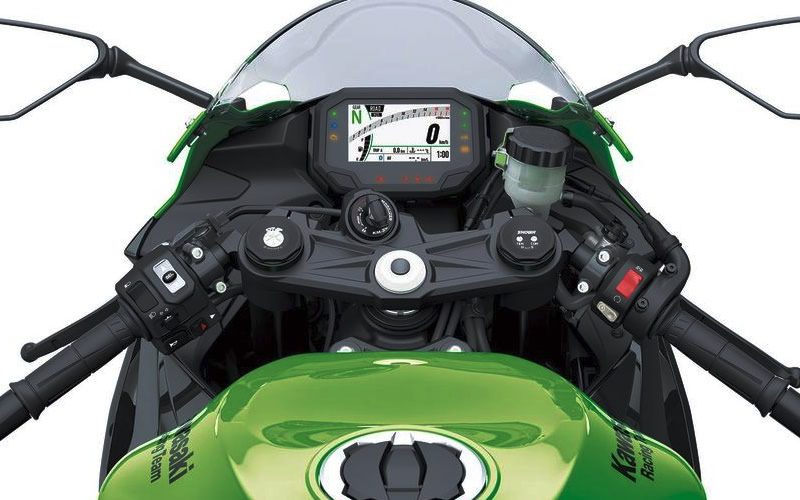
ZX636-J, 2024 year, dashboard
Visually, the new design is as expected, inspired by the Ninja ZX-10R. A hybrid headlight (projection/reflection), full LED lighting, and a new sport windshield with special cutouts to reduce turbulence complete the new package.
Technical specifications
| ZX600F (1995) | ZX600G (1998) | ZX600J (2000) | ZX636A (2002) | ZX636B (2003) | ZX636C (2005) | ZX600P (2007) | ZX600R (2009) | ZX636E (2013) | ZX636G (2019) | ZX636J (2024) | |
| Engine type | Liquid-cooled 4-stroke inline four-cylinder | ||||||||||
| Displacement | 599 cm³ | 636 cm³ | 599 cm³ | 636 cm³ | |||||||
| Bore × Stroke | 66.0×43.8 mm | 68.0×43.8 mm | 67.0×42.5 mm | 67.0×45.1 mm | |||||||
| Power | 74 kW (100 hp) at 12500/min | 79 kW (108 hp) at 12000/min | 82 kW (111 hp) at 12500/min | 83 kW (113 hp) at 12500/min | 87 kW (118 hp) at 13000/min | 95.5 kW (130 hp) at 14000/min | 91.9 kW (125 hp) at 14000/min | 94.1 kW (128 hp) at 14000/min | 96.4 kW (131 hp) at 13500/min | 95.4 kW (130 hp) at 13500/min | 91 kW (124 hp) at 13000/min |
| Max torque | 64 Nm at 10000/min | 65 Nm at 10000/min | 66 Nm at 10000/min | 71 Nm at 9800/min | 67 Nm at 11000/min | 70.5 Nm at 11500/min | 66 Nm at 11700/min | 66.7 Nm at 11800/min | 71 Nm at 11,500/min | 70.8 Nm at 11000/min | 69 Nm at 10800/min |
| Acceleration 0–100 km/h 0–200 km/h | 3.1 s 10.9 s | 3.1 s 11.5 s | 3.5 s 9.9 s | 3.4 s 9.9 s | 3.4 s 9.6 s | 3.4 s 9.8 s | |||||
| Compression ratio | 11.8:1 | 12.8:1 | 12.9:1 | 13.9:1 | 13.3:1 | 12.9:1 | |||||
| Fuel preparation | Carburetor (Keihin) | Carburetor (Mikuni BDSR 36 R x 4) | Intake manifold injection Ø38 mm x 4 with secondary throttle valves | Intake manifold injection Ø38 mm x 4 (Keihin) with oval secondary throttle valves and two injectors per cylinder | |||||||
| Fuel consumption | 4.8 l/100 km | 5.3 l/100 km | 5.2 l/100 km | 4.8 l/100 km | 5.1 l/100 km | 4.9 l/100 km | 5.5 l/100 km | 6.1 l/100 km | |||
| Emissions standard | - | - | - | - | - | - | Euro 3 | Euro 4 | Euro 5 | ||
| Transmission | 6-speed, manual | 6-speed, manual, KQS | |||||||||
| Final drive | X-ring chain | ||||||||||
| Anti-lock braking system | no | yes (optional) | yes | ||||||||
| Top speed, km/h | 249 | 250 | 259 | 265 | 262 | 262 | 260 | ||||
| Steering head angle / trail | 23.5°/91 mm | 23.5°/95 mm | 25°/106 mm | 25°/110 mm | 24°/103 mm | 23.5°/101 mm | |||||
| Front tire size | 120/60 ZR17 | 120/65 ZR17 (56W) | 120/70 ZR17M/C (58W) | ||||||||
| Rear tire size | 160/60 ZR17 | 170/60 ZR17 | 180/55 5R17 M/C (73W) | ||||||||
| Seat height, mm | 815 | 820 | 825 | 820 | 815 | 830 | |||||
| Ground clearance, mm | 140 | 145 | 130 | 120 | 130 | ||||||
| Dimensions, mm (LxWxH) | 2055 x 715 x 1160 | 2020 x 830 x 1160 | 2030 x 730 x 1175 | 2025 x 720 x 1110 | 2065 x 715 x 1110 | 2105 x 720 x 1125 | 2090 x 705 x 1115 | 2085 x 705 x 1115 | 2025 x 710 x 1100 | 2025 x 710 x 1105 | |
| Wheelbase, mm | 1400 | 1390 | 1405 | 1400 | 1395 | 1400 | |||||
| Dry weight, kg | 182 | 176 | 172 | 174 | 161 | 164 | 167 | 164 | |||
| Fuel tank capacity, l (including reserve) | 18 | 18 (5) | 18 | 17 | |||||||
| Curb weight, kg | 206 | 200 | 197 | - | 188 | 192 | 194 | 191 | 194 | 196 | 198 |
- Information for owner
- Introduction to manual
- Troubleshooting
- Engine and systems
- Engine repair
- Fuel system
- Carburetor repair
- Cooling system
- Lube system
- Transmission
- Running gear and frame
- Frame and hinged elements
- Wheels and tires
- Brake system
- Front suspension and handlebar
- Rear suspension
- Electric equipment
- Equipment and devices
- Starting and charging system
- Ignition system
- Electrical circuits
